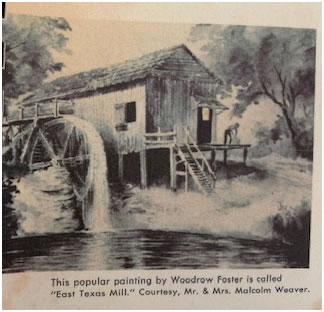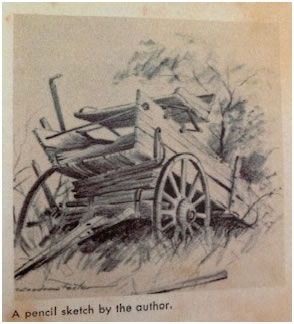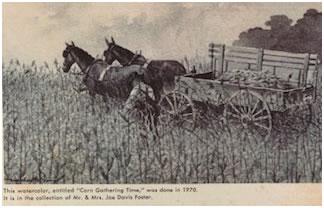

Tidbits of Shelby County History
Woodrow Foster
This week’s article is taken from several different articles found in the museum about the life of Woodrow Foster. The dates and authors of the material is unknown.
Present day society cannot imagine life in 1912. Our country was still new and not fully developed. Woodrow’s parents, Tom and Annie Blanton Foster, were sharecroppers moving west from Georgia with their family so that they might have a better life. They traveled by rail and wagons. To obtain money to move farther west, they would stop and work for farmers along the way. The family lived for a while in Panola County and when they were able moved on to Stephenville, in Erath County. Their destination was to be near their son, Roy, who was already living n Floyd County on the Cap Rock.
While the family was living in Stephenville, Woodrow was born on November 5, 1912. The same day Woodrow Wilson was elected president of the United States. Thus, his name, Woodrow Wilson Foster.
When Woodrow was 4 years old the family moved on west again, they made the trip in covered wagons. Yes, like in the movies. Woodrow remembers riding on the spring seat beside his dad and asking, “where is Roy?” when they topped the Cap Rock. (For those not familiar with the term “Cap Rock” it is the geographical transition point between the elevated plains of the Llano Estacado and the surrounding rolling terrain of the Texas Panhandle just northwest of Abilene.) The trip west spanned a distance of about three hundred miles.
When they arrived at the destination, they lived in a one-room shack with a dirt floor, one of the wagons and a tent. At night Woodrow was taken to the wagon to sleep and remembers snuggling down into the blankets to coyotes howling in the night. The family lived there until they were able to move into a house near Floydada.
On Woodrow first day of school in Floydada, he and one of his older brothers rode a mean little Spanish pony. This was about 3 miles from home. On his first day at school, he told his teacher “I can draw”. Of course, she had him go to the blackboard and demonstrate. He later stated he did not know what he drew. His earliest attempt at drawing came when Woodrow was about 4 years old. Crawling behind his mother’s “Quilt Box” with a pencil, Woodrow gave to the world his inspired interpretation of a barbed wire fence. Viewed in later years it amounted to a series of rough squares linked together with some very uninhibited lines. When Woodrow was in the third grade, the family moved to the Sandhill Community and there he attended Sandhill School thru the 8th grade. There he participated and excelled in all sports. His baseball team played the much bigger school at Floydada. If there had been state tournaments in those days, his ball club would have been in the playoffs. Even in Woodrow’s later life, he loved sports and played baseball with the local community team and his grandchildren.
Woodrow began painting with oils in 1933. The first painting on location from nature was made in Palo Duro Canyon. The canyon had been carved from the Plains by eons of time, the elements, and Prairie Dog Creek. Palo Duro is now a Texas State Park.
The family subscribed to a farm magazine, “The Country Gentleman”, that published young aspiring writer editorials. Woodrow wrote an article for the magazine, and it was published. A young woman back in east Texas, Lorene Hughes, also subscribed to this same magazine and read Woodrow’s editorial. She was also interested in art and literature. She wrote Woodrow and he responded. After a time of writing back and forth, Woodrow came to Center to meet Lorene and her parents, Herbert and Lillie Hughes.
They were married on September 9, 1936, in Center and moved to Peterburg, Texas to live with Woodrow’s parents, Tom and Annie Foster. This was during the depression years and life was hard. Dust storms had ravished the land and farms were going under due to drought and no money.
Without anything to keep him busy, Woodrow decided he wanted to play the fiddle. He could play the “French harp”, so he knew he could learn the fiddle. He ordered a violin from the Sears Roebuck catalogue. And with the determination that followed throughout his life he achieved his goal. (Note: There is a painting of Woodrow playing his fiddle in the museum.)
In the spring of 1937, Woodrow soon started studying art by correspondence. He would work on the farm all day, then do his lessons at night by the light of a kerosene lamp. Sometimes with a screaming dust storm blowing outside, the fine powdered dust would find its way inside, settling on everything including his nice drawing paper. Woodrow finished the art course in two years and decided to give art a try. Woodrow and his wife moved to Weatherford, Texas in 1938 where they managed to survive for a few months on his earnings from painting signs and showcards for the more enterprising merchants. Somehow, Woodrow got word a theatre in Seagraves, Texas wanted a “Lobby Artist.” Since he had done quite well with the theatre poster section of the Federal Schools art course, the couple took off westward again.
Woodrow began working for the Wallace Movie Theater in Seagraves, Texas where he earned about $15 a week. He did all the display art for the movies, decorated the theater for holidays, ran the movie projector, popped popcorn, took up tickets, you name it he did the job. On Christmas Woodrow did a cut-out display against the sky by day and flood-lighted by night, were the Three Wise Men, camels, and the Star of Bethlehem. His artwork for the holidays won the theater great reviews from the local paper and as far away as Ft. Worth. While living in Seagraves, Woodrow stayed in a tent as there was no public housing.
While living in Seagraves, the couple had met Lloyd and Grace Stevens They became lifelong friends. With determination to find work, Woodrow and Lloyd went into Ft. Worth and scouted every weekend. They found housing in an apartment duplex that required the couples to share a kitchen. It was decided with helping each other with money they had managed to save, they could move and have a better chance of locating a job. In 1940 Woodrow and his wife moved to Ft. Worth. Woodrow was lucky enough to obtain a job in the art department at Leonard Brothers department store in downtown Ft. Worth. At that time, it was one of the largest stores in Ft. Worth, covering a city block. He did signs, show cards, artwork and window displays for twenty-eight departments. A display for sporting goods won first prize in a national contest. Once, when the store was having a big “Round-up” sale, Woodrow painted a large cut-out of a cowboy sitting on a corral fence. The boss came by, looked it over and said, “I like it make twenty-seven more and have them ready by Saturday.”
When WWII broke out, the United States was in a turmoil. Everything was rationed and valuable metals went to building tanks and warfare products for the armed forces. In Ft. Worth, Consolidated Vultee, or Convair, aircraft factory needed draftsmen. Woodrow and Lorene both applied for work and was accepted. There, Woodrow helped to illustrate the Pilot’s Handbook, the Parts Catalogue and the Maintenance Manual for the B-24 and C-87 aircraft. One of his most difficult assignments was to make a drawing to scale, in perspective, showing the construction of the tail section of the B-36 which at that time had never been built. He had to do this entirely from the blueprints. It was very exacting and tedious work. He learned valuable assets on the job; patience and discipline in working along with a priceless drawing experience.
In 1946 an urge for more freedom and country living brought on a move to Shelby County, Texas. Woodrow and his wife moved to the old Elkanah Hughes home place 75-acre farm where they began the operation of a small dairy. Their daughter, Sara Beth, was born August 24, 1945, in Ft. Worth. They made the move to east Texas when she was 4 months old. With a lot of hard work, Woodrow and his wife, got the old place in good shape. He always found time to paint between milking the cows and the thousand other chores. He soon began to win first-place prizes in fairs around the country and began getting a few painting commissions, too.
As time passed art once again came to be foremost. Gradually dairying and raising chickens became something in the past. The dairy barn was converted into an art studio. A dream had materialized.
Although oils were Woodrow’s first love, watercolor became his favorite medium. He would always make a pencil sketch from nature with a few color notes. The actual painting was done in studio with only the sketch as reference. Whether he was doing an oil or watercolor, the sketch was enlarged with a projector. This saved time and work. He would sketch in a light pencil outline of the principal objects before applying color. He would use a great deal of detail because this would give a greater feeling of truth and authenticity. Woodrow did not adhere to a given formal without variation.
Woodrow’s work has been sold the last years through a private agent. He had twenty one-man shows over the eastern section of Texas and Western Louisiana. He sold paintings to people of all walks of life, from farmers to an ex-Governor of Texas, also to banks and other institutions.
The greatest part of his work was in landscape, still life and flower pieces. The “still lifes are usually close-up or “spot pictures.” Woodrow saw a way of helping the family income by providing art classes. He taught art for over 20 years, two to three days a week in the old dairy barn. And continued to produce beautiful paintings for customers at the same time. His eyesight became so bad in his mid-nineties he finally closed his art classes and retired when he knew the quality of work would not be the same that his clients expected. The person who purchased his last oil painting around 2001 has the most valuable painting he ever painted. It was the last one. Toward the end of his career if you were around Woodrow for very long you would leave with a pencil drawing of one of his cartoon characters.
Woodrow lost his partner, Lorene, after 70 ½ years of marriage on April 13, 2007. Woodrow WilsonFoster, of the short Community passed away September 15, 2014, at the age of 101. He lived at his home until 2012, when at 100 years of age, he moved to Henerson to live with his daughter, Sara Beth Foster Hancock. He received the Texas State Artist honor in 1991-1992 with the support of then state senator, Bill Haley. This was one of his major achievements and one he was most proud.
Note: The current exhibit, Pictorial History of Shelby County, will be taken down at the end of October for the next exhibit. If you haven’t visited the museum to see this exhibit, please do so soon. The plans for the new exhibit will by “Toys and Trains”. If anyone has old toys or train sets to loan the museum, it will be greatly appreciated. These items can be loaned for this exhibit only and will have signs stating do not touch. The museum volunteers need your help!! I will continue to send out photos of the current exhibit until all photos have been shared. I will send the next group of photos in a separate email. I do want to “Thank everyone” who made this exhibit probably. Enjoy!!
Vickie Sample Martin
Volunteer



